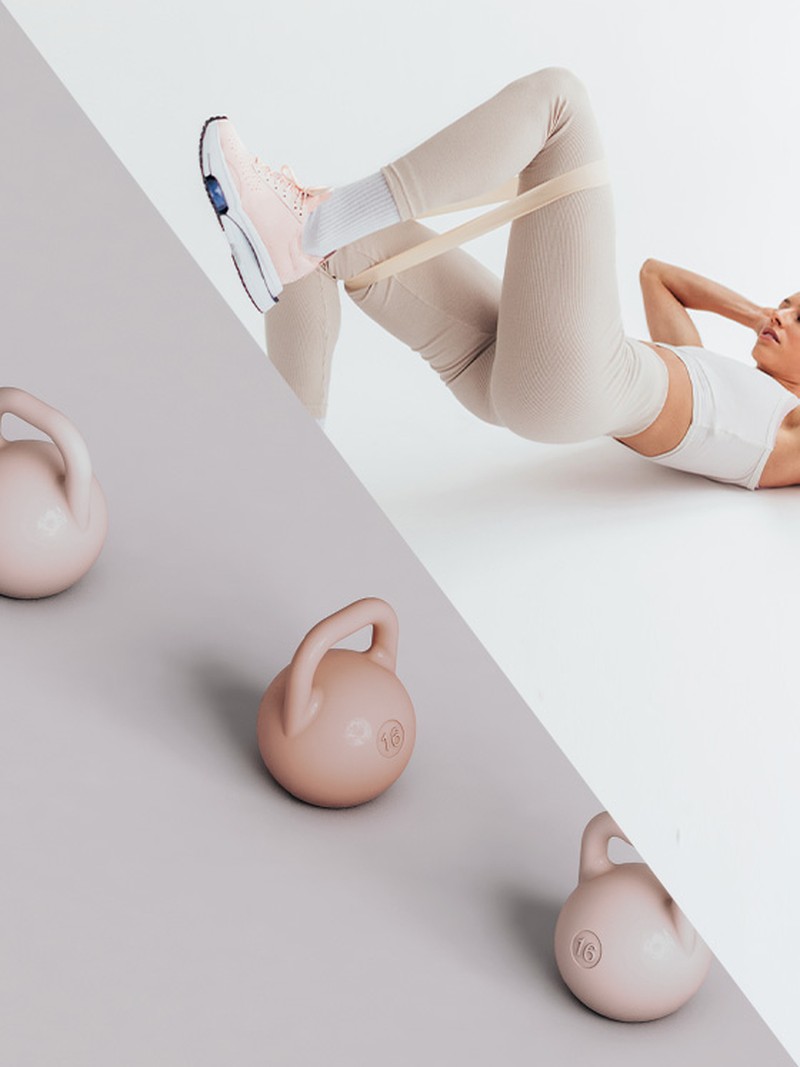Expert Tips To Make The Most Of Weights & Resistance Bands
DO
Turn To Weights To Build Lean Muscle
“There are endless benefits to adding weights into your workout routine. Strength training – however it’s done – will improve posture, flexibility, athletic performance and endurance. However, free weights, such as a pair of dumbbells, are more effective when it comes to enhancing strength and building muscle. Although you can target similar muscle groups with bands and weights, it’s the intensity and load that differs. Whether you do a squat with a resistance band or a kettlebell, you are using the same muscles – the difference is where the load is being placed and how the muscles adapt. To get stronger, you need to progressively overload – i.e. add more weight or volume to the movements you’re doing. Bands make this tricky, so weights are the best option if you’re training for performance or to get stronger.” – Aimee Cringle, PT
Lift Weights If You Want To Track Progress
“There’s a time and place for a resistance band, but if you’re someone that trains with numbers and likes to measure progress, that kind of training can be frustrating. With a set of weights, it’s easier to both track and see progress. At the same time, lifting heavier weights releases a huge number of endorphins, which provides great mental stimulation.” – Maria Eleftheriou, head of barre at Psycle
Sculpt & Tone With Bands
“To look more athletic and defined, resistance bands are your best friend. When using a band, your muscles spend more time under tension, giving you more bang for your buck. This also means you train as a whole, activating the lower and upper body as well as the core, whereas using weights only works a muscle in isolation. In a nutshell, a resistance band creates more movement per rep, which uses multiple muscle groups. At the same time, bands sculpt your smaller intrinsic muscles, creating a lean look without bulk – there’s a reason they’re popular with dancers.” – Maria
Embrace The Versatility Of Bands
“Resistance bands are arguably more versatile than dumbbells. They’re transportable, relatively easy to use and can provide an equivalent stimulus to dumbbells. They’re also an excellent tool to improve your range of motion. By using resistance bands, you can perform exercises that can be tricky – or even impossible – to do with free weights alone. For example, using resistance bands can help you perform deeper squats or lunges.” – Natasha Ram, trainer at F45 Mill Hill
Think About Your Hormones
“If you are lifting free weights, it’s important to be aware of your menstrual cycle, as during certain points of the month, it can feel harder to lift. Studies also show women are more prone to injury just before and during their period, so keep in mind how you feel throughout the month. It can be a good idea to use bands at certain points in your cycle – they’ll still tone effectively and increase endorphins without putting excessive stress and strain on the body.” – Aimee
Try Barre
“If weights are great for muscle growth, then resistance bands are useful for all things endurance, stability and flexibility. A form of training like barre uses both, ultimately building a stronger body and allowing you to move through daily life more easily with less aches and pains.” – Gen Greensted, The Barre Coach

DON’T
Think You Can’t Use Both Simultaneously
“Don’t think you have to choose between the two. Used together – either at the same time or in your workouts throughout the week – will add challenge and variety to your workouts. Add a resistance band to the bottom of your thighs when doing a glute bridge or loop a long resistance band around your shoulders when doing weighted squats, which will add an extra challenge for your hip muscles.” – Klaudia Lucia, PT
Be Impatient
“Weights and bands are both valuable tools, and the choice ultimately depends on your preferences and fitness goals. Weights are great for building strength rapidly but can be intimidating and put undue stress on joints, especially if you’re new to strength training. Resistance bands, on the other hand, are all about total body activation – they make every move count. They may not provide the swift muscle growth that weights do, but they are incredible for enhancing endurance and stability. The good news is bands provide flexibility and adaptability than weights, making them ideal for slotting into your workouts each week for continued results.” – Gen
Hit A Plateau
“Whether you’re sculpting fine lines with weights or a resistance band, knowing when to level up is the key to continued results. To safely and effectively progress, start by choosing a weight with which you can do eight to 12 reps of an exercise with good form, then gradually increase the weight you are lifting in small increments as the movement becomes easier. For example, if you can overhead press 6kg dumbbells for multiple sets of 12 reps comfortable, move to 7kg in your next workout. If you prefer to use a band, prioritise technique, ensuring you’re using a band that adequately challenges you – the last few reps should feel challenging. Generally, the thicker the band, the heavier the resistance, so scale things up if needed.” – Klaudia
Rush Into Strength Training
“If you’re new to strength training, consider starting with resistance bands, which tend to be gentler on joints because of their constant tension, as opposed to a sudden, heavy load. With free weights, the risk of injury tends to increase as you lift heavier, and incorrect technique can lead to strained muscles, tendons and ligaments. Some exercises, like heavy deadlifts and squats, can place increased stress on joints, especially our knees, shoulders and lower back. Though weights and bands can both be adapted for any fitness level, bands are a particularly helpful way to slowly build strength and learn movement patterns.” – Klaudia
Think It’s All About Building Muscle
“Strength training doesn’t have to mean lifting intimidating weights to the point of failure. In barre, both weights and resistance bands are used to give you an effective total-body workout that focuses not only on strength but also flexibility and stability – a physiotherapist’s dream. Resistance bands pull strength training and physical therapy together. Although it may take a little longer to reach strength goals when using bands, the benefit to your overall endurance and stability is unparalleled.” – Gen
For more from the experts, visit TheBarreCoach.com, PsycleLondon.com, F45Training.co.uk and follow @Aimee_Cringle & @WyzyFit.
DISCLAIMER: Features published by SheerLuxe are not intended to treat, diagnose, cure or prevent any disease. Always seek the advice of your GP or another qualified healthcare provider for any questions you have regarding a medical condition, and before undertaking any diet, exercise or other health-related programme.
DISCLAIMER: We endeavour to always credit the correct original source of every image we use. If you think a credit may be incorrect, please contact us at info@sheerluxe.com.


